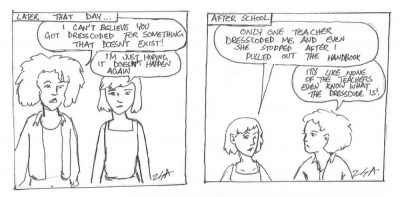
A growing concern in the middle school student body is the school attire policy. The common sentiment among students in the upper grades is that the rules and regulations for what students can and cannot wear are in need of clarification.
The attire policy in its present state is a series of questions followed by some specific restrictions. These questions are put in place so that students can best decide how to dress, and what their opinion is on their attire. However, there have been instances where students have frequently been called out by teachers, and on many of these occasions, students feel that the application of the attire policy is unfair. I believe the attire policy itself should be changed because as of right now, it is unclear on how teachers are supposed to enforce it.
This lack of clarification in the attire policy needs to be put right as it causes uncertainty between teachers and students. While one teacher might think that, based on the questions put in place, a student’s outfit doesn’t fall within the guidelines, the student in question

I disagree and believe that they are appropriately dressed.
Also, the students, technically speaking, should not be called out at all because of the way that these questions are phrased. For example, one of the questions is “Am I dressed for school?” This question insinuates that it is up to the wearer to decide whether or not they are dressed for school
. This is because of the use of ‘I’ in the sentence, and because of the specification that students “use the following questions to make thoughtful choices about attire.” There is no mention of teacher’s interpretations of your clothing choices affecting whether or not you can be dress-coded.
Speaking from a personal experience I know that it can be frustrating to be called out when you believe that your outfit does fall within the attire policy while the teacher does not. My clothing was pointed out because a teacher thought that I wasn’t dressed for the cold weather, but I thought that I was fine because I was wearing tights with my skirt and didn’t feel cold at all. It was implied that I shouldn’t wear this type of outfit again, although it was not explicitly stated.
If there was a rule saying that you can’t have bare legs, then the answer would be clear; I couldn’t be called out as I was wearing tights. This shows a clear flaw in the attire policy as there are no specific rules a student has to follow. The attire policy in its current state leaves the student body wondering whose opinions matter more in relation to the attire policy questions. The questions insinuate that students may ask themselves whether they are comfortable with their clothing choices, but the attire policy is to be enforced by teachers. The issues with the attire policy and what the rules that students must follow, are in need of an urgent clarification.
It is time to look for the answers rather than to continuously go around in circles discussing the same points over and over again. Eighth-grader Claire Heskett said, “The dress code is confusing, and doesn’t really tell people what they can and cannot wear.”
To find the solutions you need to start with the problems and look at what you specifically want to be changed. The attire policy has very few specifications on what students can and can not wear. A new attire policy needs to include the specifics of what you can be dress coded for and not a series of questions that are left to interpretation by teachers and students alike. The solutions for a new attire policy won’t come easily. There will always be those who will have small issues with parts of the attire policy, and there are a number of reasons that people may be opposed to certain aspects of ideas put forward. However, everyone needs to keep an open mind about what may be presented as a solution, there will never be a perfect solution but there will hopefully be one that comes close.
Many are in agreement that the attire policy needs to be changed this is clearly shown through the many current efforts by the Middle School Student Council and the eighth grade Student Senate. There are many people looking for a viable solution to this ongoing and complex situation. I hope that when that solution does come along that many people will be a part of the solution and not part of the problem.
